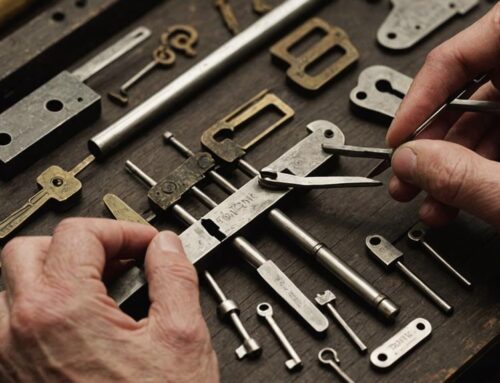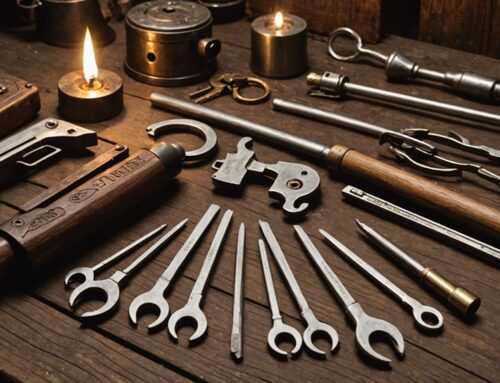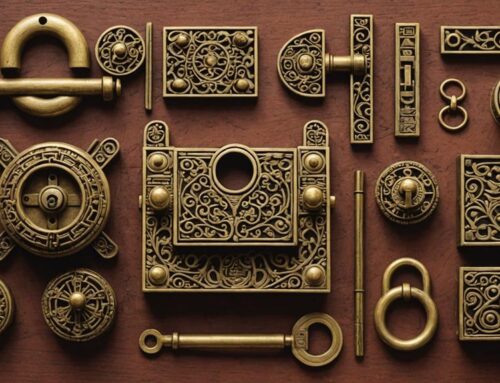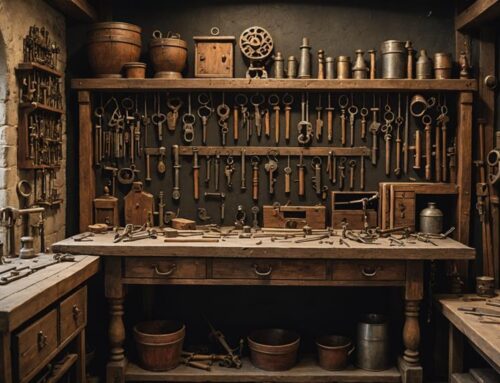You’re not alone in this locked out dilemma, and we’ve got you covered. With our comprehensive guide, you’ll master the art of using a knife to unlock doors. It’s more than just jiggling a blade – it’s understanding locks, selecting the perfect knife, and finessing your technique. Remember, this is for responsible use only. So, ready to unlock this skill? Let’s dive in.
Key Takeaways
- Determine the type of lock and understand how it works
- Use the appropriate knife for the type of lock (butter knife, putty knife, pocket knife, paperclip, hair clip)
- Apply pressure and wiggle the knife in the keyhole to pick the lock
- Use alternative tools like a paperclip, tension wrench, credit card, small hex key, or flat head screwdriver if needed
Understanding Different Lock Mechanisms
You’re currently delving into the complexities of different lock mechanisms, and it’s crucial to understand whether you’re dealing with a spring-loaded latch system or a button lock. Knowing the type of lock you’re up against is the first step in successfully picking it. For instance, a spring-loaded latch system can often be manipulated using a simple tool like a butter knife, while a button lock requires a more nuanced approach. Understanding this distinction is key to your success. Moreover, it’s important to approach lock-picking with respect for the intricacies of the mechanisms at work. Each type of lock is a puzzle waiting to be solved, and with the right knowledge and tools, you’ll be well on your way to mastering this skill.
Selecting the Appropriate Knife for Lock Picking
In light of the current discussion about selecting the appropriate knife for lock picking, it’s crucial that you consider both the size and type of lock you’re dealing with, and also the potential risk of damaging the lock or injuring yourself.
- Assess the lock: Be familiar with the lock’s mechanism. It determines which tool is suitable.
- Choose the knife: Different types of knives for lock picking exist, such as butter, putty, or pocket knives, each with its own pros and cons.
- Use alternative tools: When knives aren’t ideal, alternative tools for lock picking like paperclips or tension wrenches might be more effective.
- Practice caution: Lock picking isn’t just about the right tools. It’s also about technique and safety. Always prioritize not causing damage or injury.
The Process of Picking a Lock With a Knife
It’s crucial to understand that there are four main steps to picking a lock with a knife: preparing the lock, selecting the right knife, attempting to pick the lock, and finally, trying out other tools if necessary. Remember, the importance of proper technique can’t be overstated. Begin by understanding the lock type and its workings. Choose a knife that suits the lock – a butter knife or pocket knife often works best.
Carefully insert the knife into the keyhole, applying gentle pressure and listening for the telltale click. If unsuccessful, don’t despair. You might need to use a credit card or paperclip as an alternative tool. Be cognizant of potential risks and dangers. It’s important not to damage the lock, the knife, or worse, injure yourself.
Incorporating Additional Tools With Knife Techniques
While you’ve got your knife technique down, incorporating a few additional tools can really enhance your lock picking skills, and don’t forget, practice always makes perfect.
- Hair Clip: A hair clip is a handy tool. It can be used as a tension wrench to apply pressure while you manipulate the lock with your knife.
- Small Hex Key: A small hex key works wonders on tougher locks. It’s sturdy and can apply more force than a knife alone.
- Tension Wrench: A tension wrench is your best friend when picking locks. It helps you control the amount of pressure you’re applying.
- Credit Card: In a pinch, a credit card can do the trick. Remember, it may get damaged in the process.
The Credit Card Method for Opening Locked Doors
You’re about to learn how the credit card method for opening locked doors can come in handy, especially when you’re locked out with nothing more than your wallet. Now, it’s important to understand the credit card limitations. Not all doors can be opened with this method, especially if they’ve got deadbolt locks. You need a door with a simple latch, the kind that’s spring-loaded. Slide your card between the door and the frame right where the latch is. Wiggle and jiggle, but if it doesn’t give, don’t force it; you might end up damaging your card. If the credit card method fails, don’t despair. Alternative door opening methods, like using a tension wrench or a lock pick, might be more suitable. Remember, this skill is all about finesse, not force.
Precautions and Warnings for Knife Lock Picking
Despite its utility, your knife’s sharp edge can pose a risk during lock picking, so heed the warnings and take necessary precautions to avoid injury. When wielded correctly, a knife can be surprisingly effective in picking a lock, yet there are common mistakes in knife lock picking that you should be wary of.
- Over-pressuring: Too much force can damage the lock or break your knife. Gentle, consistent pressure is key.
- Wrong knife selection: A butter knife is often more suitable than a sharper blade.
- Inadequate understanding of the lock mechanism: Study the lock before you begin.
- Failure to maintain safety: Keep your fingers clear of the blade’s path.
Master these aspects and enjoy the advantages of lock picking with a knife, but remember, safety first!
Expert Tips for Successful Lock Picking
Before you even begin, it’s crucial that you understand the type of lock you’re dealing with, as this will influence the tools and techniques you’ll need for successful lock picking. The importance of technique in lock picking cannot be overstated. It’s a skill that requires patience, precision, and a keen understanding of different lock mechanisms.
Avoid common mistakes in lock picking such as forcing the lock or using the wrong tools. Always remember, each lock is a puzzle waiting to be solved, and you’re the puzzle master.
| Lock Type | Appropriate Tool | Common Mistake |
|---|---|---|
| Spring-Loaded Latch | Butter Knife | Forcing the Lock |
| Button Lock | Putty Knife | Using Wrong Tool |
| Pin Tumbler | Paperclip | Lack of Patience |
| Lever-Type Doorknob | Credit Card | Damaging the Card |
You’re part of an intricate world of lock picking. Welcome, and pick wisely.
The Role of Patience and Technique in Lock Picking
In lock picking, patience becomes your best ally, and without the right technique, you won’t make much progress. The importance of practice and precision in lock picking cannot be overemphasized.
- Practice: Like any skill, you’ll only get better with consistent practice. Start with simple locks and gradually move to complex ones.
- Precision: It’s all about the small movements. A slight change in pressure can make a big difference.
- Patience: Sometimes, it might take a while to pick a lock. Don’t rush. Take your time and learn from each attempt.
- Legal Implications: Be aware that lock picking carries potential risks and legal implications. It’s a skill to be used responsibly and legally.
Other Effective Methods for Opening Locked Doors
You’ve learned about lock picking, but there are also other methods like using a credit card, a small hex key, or a flat head screwdriver, and it’s always good to have multiple techniques under your belt. These alternative lock picking methods can be just as effective if you’re in a bind. For instance, slipping a credit card between the door and the frame can release a latch lock. A hex key can turn a simple interior lock with ease. Even a flat head screwdriver can push a bolt out of a door jamb. Remember, using improvised tools requires finesse and patience, just like traditional lock picking. You’re part of a community that values resourcefulness and ingenuity, so don’t be afraid to try new methods and share your experiences.
Frequently Asked Questions
What Are Some Other Household Items That Can Be Used in Lock Picking Aside From a Knife and a Credit Card?
You can use everyday items like paperclips, hair clips, or small hex keys as improvised lock picking tools. However, remember lock picking ethics. It’s illegal and intrusive to pick locks that aren’t yours.
How Can I Maintain My Safety While Trying to Pick a Lock With a Knife?
While it might seem daunting, you can safely pick a lock with a knife. Just take it slow, use a blunt knife to avoid cuts, and remember: practice makes perfect. Mastering improvised lock picks takes time.
What Type of Locks Are Impossible to Pick Using a Knife?
High-security locks, such as tubular or disc-detainer locks, can’t be picked with a knife. They’ve complex mechanisms that knives can’t manipulate. Always remember lock picking ethics and choose your tools wisely.
Are There Any Legal Implications of Picking a Lock, Even if It’s Your Own Property?
Yes, there are legal implications. Even if it’s your property, picking a lock could potentially result in damage. This could void warranties or violate rental agreements, infringing on ownership rights and causing legal consequences.
Can Professionals Use the Same Knife Techniques in Their Practice or Do They Use Specialized Tools?
Yes, you as a professional can use knife techniques, but specialized locksmith tools are normally used. They’re more effective and reduce risk of damage. Remember, professional training relevance is vital for mastering these tools.








